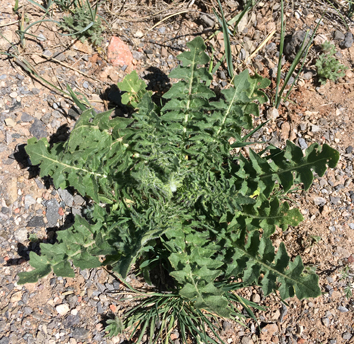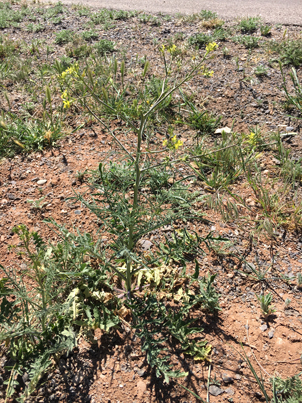
Location
Close to road leading from church parking lot to #16 (N35D32'57.131 X W105D41'15.930)
Flowers first observed: 4/8/17
The Rosette

The Plant w/Flowers

The Flowers and Pods

Distribution
"It is hardy to zone (UK) 7. It is in flower from Jul to September, and the seeds ripen from Aug to September. The flowers are hermaphrodite (have both male and female organs) and are pollinated by Self.The plant is self-fertile. Suitable for: light (sandy) and medium (loamy) soils and prefers well-drained soil. Suitable pH: acid, neutral and basic (alkaline) soils. It cannot grow in the shade. It prefers moist soil." (Plants for a Future)
Description
"The inflorescence is a narrow, elongated cluster. Flowerheads are formed of between 12 and 20 pale yellow ray florets, which have four notches at the tip. Phyllaries are relatively broad, green or reddish in color and triangular (at the base) to lanceolate (at the top) in shape. They stay pressed against the involucre during flowering but tend to bend outwards at the fruiting stage. Flowerheads are about half an inch in diameter." (The American Southwest)
Ethnobotanical Uses
Food:
"Young leaves - raw or cooked[13, 55, 62]. A bitter flavour[85]. The young tender leaves are mild and make an excellent salad[183, 217], but the whole plant becomes bitter as it gets older, especially when coming into flower[K]. As a potherb it needs very little cooking[183]. Large quantities can cause digestive upsets[62]. Young shoots - cooked. Used as an asparagus substitute[13]. An edible oil is obtained from the seed[46, 61, 105]. The oil must be refined before it is edible[114]. A pleasant flavour[114, 183]." (Plants for a Future)
"Lactuca serriola can be eaten as a salad, although it has something of a bitter taste. Young leaves can be eaten raw or cooked.[11] However, its presence in some ancient deposits has been linked more to its soporific properties which might suggest ritual use."(Wikipedia)
Medicine:
"Navajo, Ramah Ceremonial Medicine and Emetic Compound decoction of plant used as a ceremonial emetic." (Moerman 294)
""The whole plant is rich in a milky sap that flows freely from any wounds. This hardens and dries when in contact with the air[4]. The sap contains 'lactucarium', which is used in medicine for its anodyne, antispasmodic, digestive, diuretic, hypnotic, narcotic and sedative properties[9, 21, 46, 165, 192, 213, 238]. Lactucarium has the effects of a feeble opium, but without its tendency to cause digestive upsets[4], nor is it addictive[7]. It is taken internally in the treatment of insomnia, anxiety, neuroses, hyperactivity in children, dry coughs, whooping cough, rheumatic pain etc[238]. Concentrations of lactucarium are low in young plants and most concentrated when the plant comes into flower[238]. It is collected commercially by cutting the heads of the plants and scraping the juice into china vessels several times a day until the plant is exhausted[4]. This species does not contain as much lactucarium as L. virosa[4]. An infusion of the fresh or dried flowering plant can also be used[9]. The plant should be used with caution, and never without the supervision of a skilled practitioner. Even normal doses can cause drowsiness whilst excess causes restlessness[238] and overdoses can cause death through cardiac paralysis[7, 9]. The fixed oil from the seeds is said to possess antipyretic and hypnotic properties[240]. A homeopathic remedy is made from the plant[9]. It is used in the treatment of chronic catarrh, coughs, swollen liver, flatulence and ailments of the urinary tract[9]." (Plants for a Future)
"The Ancient Greeks also believed its pungent juice to be a remedy against eye ulcers and Pythagoreanscalled the lettuce eunuch because it caused urination and relaxed sexual desire. The Navajo used the plant as a ceremonial emetic.[12] In the island of Crete in Greece the leaves and the tender shoots of a variety called maroula (μαρούλα) or agriomaroulo (αγριομάρουλο) are eaten boiled.[13] It is used by a growing number of Jews and the Samaritans as the Maror (bitter herb) on Pesach." (Wikipedia)
Other Uses:
"The seed contains 35.2% of a semi-drying oil[240]. It is used in soap making, paints, varnishes etc[114]." (Plants for a Future)
Internet Links